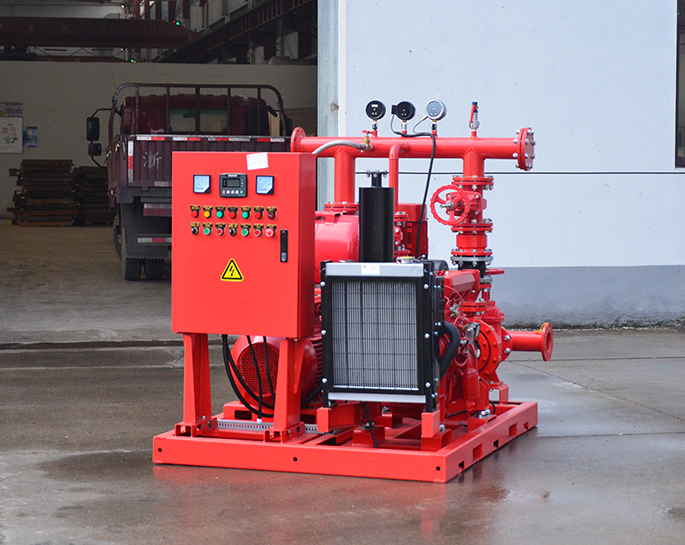What is the role of water storage tanks in conjunction with fire pumps, and how are they sized?
Feb 04, 2024
Share:
Water storage tanks play a crucial role in conjunction with fire pumps as part of a fire protection system. These systems are designed to provide an adequate and reliable water supply for firefighting in case of an emergency. The primary purpose of water storage tanks is to ensure a steady and sufficient water source for fire pumps, which can then distribute water to the fire sprinkler system or hydrants.
Here are the key roles of water storage tanks in conjunction with fire pumps:
1. **Emergency Water Supply:** Water storage tanks serve as an emergency reservoir, providing a readily available water source for firefighting efforts when the standard municipal water supply is insufficient or unavailable.
2. **Maintaining Pressure:** Fire pumps require a certain level of pressure to operate effectively. The elevated water in storage tanks helps create the necessary pressure, ensuring that the fire pumps can deliver water to the fire protection system with adequate force.
3. **Compensating for Insufficient Municipal Supply:** In some cases, municipal water supplies may not be able to meet the demand during a fire emergency, especially in remote or high-risk areas. Water storage tanks act as a supplement, compensating for any deficiencies in the municipal supply.
The sizing of water storage tanks in conjunction with fire pumps involves careful consideration of various factors:
1. **Fire Protection Requirements:** The required capacity of the storage tank is determined by the fire protection needs of the building or facility. This is typically based on factors such as the size of the structure, the occupancy type, and the potential fire hazards.
2. **Flow and Duration:** The flow rate and duration of water supply needed during a fire emergency play a crucial role in sizing the storage tank. Engineers consider factors such as the fire pump capacity, the type of fire protection system, and the expected duration of firefighting efforts.
3. **Local Regulations and Codes:** Building codes and regulations often stipulate specific requirements for fire protection systems, including the sizing of water storage tanks. Compliance with these regulations is essential for ensuring the safety and effectiveness of the fire protection system.
4. **Hydraulic Analysis:** Engineers may conduct a hydraulic analysis to evaluate the performance of the fire protection system. This analysis considers factors such as pressure losses in pipes, elevation changes, and the required flow rates to determine the appropriate size of the storage tank.
In summary, water storage tanks are integral to fire protection systems by providing a reliable and supplementary water source for fire pumps. Sizing considerations involve a detailed analysis of the specific needs of the building, local regulations, and the hydraulic characteristics of the system.

Here are the key roles of water storage tanks in conjunction with fire pumps:
1. **Emergency Water Supply:** Water storage tanks serve as an emergency reservoir, providing a readily available water source for firefighting efforts when the standard municipal water supply is insufficient or unavailable.
2. **Maintaining Pressure:** Fire pumps require a certain level of pressure to operate effectively. The elevated water in storage tanks helps create the necessary pressure, ensuring that the fire pumps can deliver water to the fire protection system with adequate force.
3. **Compensating for Insufficient Municipal Supply:** In some cases, municipal water supplies may not be able to meet the demand during a fire emergency, especially in remote or high-risk areas. Water storage tanks act as a supplement, compensating for any deficiencies in the municipal supply.
The sizing of water storage tanks in conjunction with fire pumps involves careful consideration of various factors:
1. **Fire Protection Requirements:** The required capacity of the storage tank is determined by the fire protection needs of the building or facility. This is typically based on factors such as the size of the structure, the occupancy type, and the potential fire hazards.
2. **Flow and Duration:** The flow rate and duration of water supply needed during a fire emergency play a crucial role in sizing the storage tank. Engineers consider factors such as the fire pump capacity, the type of fire protection system, and the expected duration of firefighting efforts.
3. **Local Regulations and Codes:** Building codes and regulations often stipulate specific requirements for fire protection systems, including the sizing of water storage tanks. Compliance with these regulations is essential for ensuring the safety and effectiveness of the fire protection system.
4. **Hydraulic Analysis:** Engineers may conduct a hydraulic analysis to evaluate the performance of the fire protection system. This analysis considers factors such as pressure losses in pipes, elevation changes, and the required flow rates to determine the appropriate size of the storage tank.
In summary, water storage tanks are integral to fire protection systems by providing a reliable and supplementary water source for fire pumps. Sizing considerations involve a detailed analysis of the specific needs of the building, local regulations, and the hydraulic characteristics of the system.


.png)
.png)

.png)


